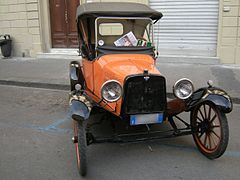History
Hugh Chalmers of Chalmers Motor Car Company began the company to market a low priced volume car. The first Saxon was a 2-seat runabout with 2-speed transmission and a four-cylinder engine made by Ferro and built in the old Demotcar factory. 7,000 were made in the first year of production. The cost of a Saxon in 1913 was $395, equivalent to $11,696in 2022. [3]
From 1913 to 1914, electric lighting was an extra option, which became a standard fitting to the car in 1915. Also available in 1915 was the Saxon Six, a five-passenger tourer, with a 30–35 hp (22–26 kW) Continental six-cylinder, electric starter and headlights, on a 112 in (2845 mm) wheelbase and 32×3½-inch (81×8.9 cm) wheels, all for $785, equivalent to $22,708in 2022. [4] [2]
In 1914 a Saxon roadster was driven 135 miles a day for 30 days, for a total of 4,050 miles with an average of 30 mpg. It was among the first cars to christen the new Lincoln Highway. Sales skyrocketed. In 1915, Harry W. Ford, formerly with Chalmers, bought out Hugh Chalmers interest and became President of a reorganized Saxon Motor Car Corporation. Early in 1915, Saxon moved production to the former Abbott factory. [2] [5]
In its peak year of 1916, 27,800 Saxons were produced. The Saxon Six was followed in 1917 by a Sedan. In December 1917, Harry W. Ford was out and the new president was Benjamin Gotfredson. From 1918 the company got into financial difficulties while expanding, with large quantities of parts and building a larger factory. The 4-cylinder models were dropped from the range and the Sedan went as well in 1919. [5] [2]
In 1919 C. A. Pfeffer, another former Chalmers manager, became president of Saxon Motor Car Corporation. The new factory Saxon couldn't pay for was sold to General Motors. In 1920 a new model, the Saxon Duplex, powered by an overhead-valve, four-cylinder engine joined the six-cylinder model and a sedan body rejoined the range. The six-cylinder cars were no longer listed after 1921 and production had fallen to 2,100 cars.
In 1921, Saxon sold off their parts business to settle debts and used the proceeds to move the company to Ypsilanti, Michigan, where the cars were made in the Ace car plant, but this could not save the company and the last cars, probably made in 1922, were sold in 1923. [5] [2]
In popular culture
Band leader George Olsen drove a Saxon. Olsen mentions this on the first Jack Benny Program, May 2, 1932. Olsen was the bandleader on that show. [6]
In the 1937 Hollywood film "Easy Living", Jean Arthur's character, a poor woman mistakenly thought to be rich, is asked to buy a car from the V16 Company of America, and answers that "of course I've never driven one; we had Saxon's... Yes I suppose they are different." [7]
It has been misreported that Saxon President Harry Ford left the company due to illness. The fact is that after raising capital for the company, Ford lost his position in a proxy fight. He subsequently joined the war effort as an officer, and died while a military officer during the influenza epidemic. [8]
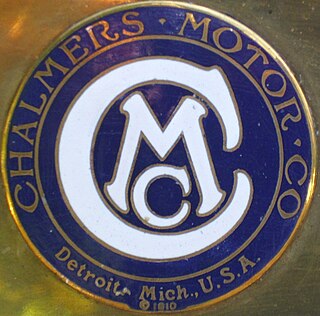
The Chalmers Motor Company was an American automobile manufacturer headquartered in Detroit, Michigan. Founded in 1908 by Hugh Chalmers, the company was known for producing high-end vehicles. Chalmers automobiles gained recognition for their toughness, durability, and engineering receiving particular praise for their performance in touring events. The company reached its peak in 1911, becoming the eighth-largest auto producer in the United States. Despite initial success, the company faced challenges with increasing competition in the auto industry, and sales began to decline in the following years. In 1923, Chalmers Motor Company merged with Maxwell Motor, ultimately forming the basis for the Chrysler Corporation.

The Ford Model N is an automobile produced by Ford Motor Company; it was introduced in 1906 as a successor to the Models A and C as the company's inexpensive, entry-level line. It was built at the Ford Piquette Avenue Plant.

Velie was a brass era American automobile brand produced by the Velie Motors Corporation in Moline, Illinois from 1908 to 1928. The company was founded by and named for Willard Velie, a maternal grandson of John Deere.

The Dort Motor Car Company of Flint, Michigan, built automobiles from 1915 to 1924.
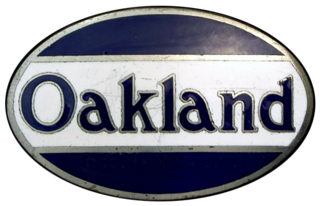
The Oakland Motor Car Company of Pontiac, Michigan, was an American automobile manufacturer and division of General Motors. Purchased by General Motors in 1909, the company continued to produce modestly priced automobiles until 1931 when the brand was dropped in favor of the division's Pontiac make.
The National Motor Vehicle Company was an American manufacturer of automobiles in Indianapolis, Indiana, between 1900 and 1924. One of its presidents, Arthur C. Newby, was also one of the investors who created the Indianapolis Motor Speedway.

Templar was a manufacturer of automobiles in Lakewood, Ohio from 1917 to 1924. The company was named for the Knights Templar and used a Maltese Cross as an emblem.

The Lexington was an automobile manufactured in Connersville, Indiana, from 1910 to 1927. From the beginning, Lexingtons, like most other Indiana-built automobiles, were assembled cars, built with components from many different suppliers. The Thoroughbred Six and Minute Man Six were popular Lexington models.

The Westcott was an automobile produced in Richmond, Indiana and Springfield, Ohio in the United States between 1909 and 1925 by the Westcott Motor Car Company. The car company was named for its founder, John Westcott.

The Marion was an automobile produced by the Marion Motor Car Company in Indianapolis, Indiana from 1904 to 1915.

Barley Motor Car Co. was a manufacturer of luxury automobiles in Kalamazoo, Michigan, and Streator, Illinois. It manufactured the Roamer automobile (1916–29) and briefly, the Barley (1922–24), and the Pennant (1924–25).
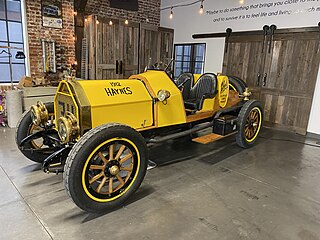
The Haynes Automobile Company also known by its badge as “Americas First Car” was an early American automobile manufacturing company that produced automobiles in Kokomo, Indiana, from 1905 to 1924. The company was formerly known as the Haynes-Apperson company, and produced automobiles under that name from 1894 to 1905. Co-founder Elwood Haynes changed the name of the company to the Haynes Automobile Co after fellow co-founders Elmer and Edgar Apperson left to form the Apperson Brothers Automobile Company in 1901. The Haynes company was declared bankrupt in 1924 and went out of business in 1925.
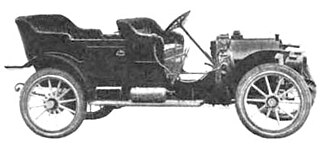
The Herreshoff was an American automobile built in both Detroit, Michigan, and Troy, New York, by the Herreshoff Motor Company from 1909 to 1914. The Herreshoff started as a small car with a 24 hp (18 kW) four-cylinder engine, and was made with three different models. Later models were upgraded to six-cylinder engines up to 3.8 liter capacity. For 1911, Herreshoff had a roadster with a rudimentary rumble seat at US$950 ; by contrast, the high-volume Oldsmobile Runabout went for $650.

Nyberg was the name of a brass era American automobile built by Henry Nyberg of Chicago, Illinois, in Anderson, Indiana, and Chattanooga, Tennessee from 1911 to 1914.

Scripps-Booth was a United States automobile marque based in Detroit, Michigan. Established by James Scripps Booth in 1913, Scripps-Booth Company produced motor vehicles and was later acquired by General Motors, becoming a division of it, until the brand was discontinued in 1923.

The Metz Company was a pioneer brass era automobile maker established by Charles Herman Metz in Waltham, Massachusetts, from 1909 to 1922.

Daniels Motor Company was a pioneer brass era American automobile company, founded in 1915 by George E. Daniels with Neff E. Parish. George Daniels was a known lawyer, engineer, and mechanic. He was considered the best motorcar designer in the United States. Neff Parish had his own automobile parts and framing manufacturing company. Neff was the creator of the time's highest-grade heat-treated alloy steel frames, respected in the steel industry. Daniels Motor Company produced 1,500 high-quality automobiles between 1916 and 1924, branding themselves as “the distinguished car with just a little more power than you will ever need”, and “The aristocrat of American cars”.

The Cunningham Car Company was a pioneering American production automobile manufacturer. Theirs was one of the earliest vehicles of the automotive age. Cunninghams were produced from 1896 to 1931 in Rochester, New York by James Cunningham, Son and Company who had been in the carriage manufacturing business since 1836.

The Oakland Six was the first six-cylinder engine offered by the Oakland Motor Company in 1913 which became a division of General Motors in 1909. The Oakland Six was offered in many different model names that changed every year, along with several body styles and engine displacements until 1929, when the V8 was reintroduced, then in 1931 Oakland was renamed Pontiac. When Oakland became a division of GM and introduced the Oakland Four, Oldsmobile and Buick shared bodywork and chassis of their six-cylinder models with Oakland. When Chevrolet became part of GM in 1917, Oakland chassis and bodywork were shared with Chevrolet. Manufacture of the Oakland was completed in Pontiac, Michigan.



